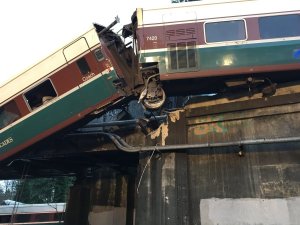(CNN) — Careening around a curve at almost three times the speed limit, an Amtrak passenger train derailed and hurled 13 of its 14 cars off both sides of an overpass and onto rush hour traffic below — killing three people and injuring more than 100 others.
Chris Karnes, a passenger on the train and chairman of the Pierce Transit Community Transportation Advisory Group, said Monday the train was moving at a “pretty good pace,” judging from the fact that it was passing cars on the highway.
“We felt a little bit of a jolt, and then at a certain point we could hear crumpling of the train car, and we were catapulted into the seats in front of us,” Karnes said.
The Amtrak Cascades 501 train was carrying 86 people as it made its inaugural journey on a new service route from Seattle to Portland when it derailed.
It’s not clear why the train was traveling 80 mph in a 30 mph zone, National Transportation Safety Board member T. Bella Dinh-Zarr said.
But this much we do know: The track had undergone millions of dollars of improvements and weeks of testing. But Positive Train Control — technology that automatically slows down and stops a speeding train — wasn’t activated.
“Something like Positive Train Control could certainly prevent it,” former NTSB member Deborah Hersman said Tuesday.
NTSB investigators arrived Monday in DuPont, the site of the accident, and will spend their first full day at the scene Tuesday.

Latest developments:
— Investigators were able to get the information about the speed from a data recorder retrieved from the rear locomotive. But the front locomotive “is more difficult to access,” Dinh-Zarr said.
— The train’s engineer has not yet been interviewed, but the NTSB hopes to have all interviews completed “within the next day or so,” Dinh-Zarr said.
— PTC was installed in the segment of tracks where the derailment happened, but wasn’t operational yet. The target date to have it working was spring quarter of 2018, said Geoff Patrick, the spokesman for Sound Transit — which owns tracks where the train derailed.
— More than 100 people were taken to hospitals in Pierce and Thurston counties, DuPont Fire Chief Larry Creekmore said. Ten people were seriously injured, and one was life-flighted to Harborview Medical Center in Seattle, Amtrak spokesman Marc Magliari said.
— All the deaths were contained to the train, said Ed Troyer, the Pierce County Sheriff’s Office spokesman.
When it derailed
The train departed Seattle at 6 a.m. Monday and had made two stops before the crash. It derailed at around 7:40 a.m. in DuPont, about 20 miles south of Tacoma, near the Billy Frank Jr. Nisqually National Wildlife Refuge.
The train apparently came out of a curve and ran off the track while crossing or approaching an open trestle over I-5. The following rail cars derailed in a jumble on both sides of the track, with some falling to the road below, landing on vehicles. One rail car dangled precariously over the highway.
Several motorists in vehicles that were struck by the fallen train cars suffered injuries, but no one on the road was killed, the sheriff’s office said. Five cars and two semi-trucks were involved in the crash, Washington State Patrol spokeswoman Brooke Bova said at a news conference.
How did this happen?
The NTSB and local authorities have not said what caused the crash.
Most of the route was graded for a maximum speed of 79 mph; the speed limit on the curve where the crash occurred is 30 mph, said Rachelle Cunningham with Sound Transit.
Witnesses said they saw the train traveling at a fast speed.
Daniel Konzelman, who was driving on Interstate 5 at the time, said the train and his car were “kind of parallel” and “it was going faster than us.”
PTC, the technology that automatically slows down and stops a train if it senses that it’s going too fast or might get into an accident, had been installed on the track, but wasn’t operational yet, said Geoff Patrick, Sound Transit spokesman.
For PTC to be fully operational, it needs to be installed in trains, because a computer system knits both the train cars and tracks together, he said. The target date for having the PTC operational for that segment of the track had been second quarter of 2018.
“The system is still being implemented,” Patrick said. “It is not operational yet.”
Investigators will likely look at several factors including the track, human performance, operations and mechanics of the train.
These are the questions investigators will be asking about the derailment
A first day goes awry
According to an online schedule, the 501 train connects “18 cities along the I-5 corridor including Seattle, Portland, Vancouver, BC, and Eugene, Oregon.” The train service is jointly owned by the Washington and Oregon departments of transportation, although Amtrak contracts to operate the service.
The train was running on track previously used for occasional freight and military transport, the Washington Department of Transportation said. The track had undergone millions of dollars of federally funded improvements and weeks of inspection and testing, the agency said.
Previously, the tracks where the derailment occurred were owned by BNSF. The tracks are now owned by Sound Transit, which managed the track upgrade in preparation for commuter service, the state department of transportation said.
Amtrak service south of Seattle was temporarily suspended. Service from Seattle to points north and east continued to operate, Amtrak said.








